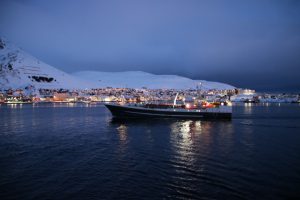Today we docked in Honningsvag at 08:50 with an air temperature of -5.4ºC and what could be when the sun rises a good day. Today, as we mentioned yesterday, sunrise is expected at 09:13 and sunset at 13:47. The first sighting of the port, which is the closest to the Cape, was actually from bed and what was actually a mountain looked like a cumulonimbus cloud.
The North Cape (Nordkapp) is the northernmost point of the island of Mageroya and the most northerly point that one can travel to on the mainland of Europe. The actual northerly point is at the village of Knivsk-jelodden, but this is only accessible on foot. The Cape sits at the top of a 307m cliff above the Arctic Ocean. Again, we are in the High Arctic but the North Atlantic Drift keeps the coastline ice-free all year round. The Cape is nearer to the North Pole than Oslo and at 71.10ºN it sees the Midnight Sun from mid-May to the end of July. This is because the northern hemisphere is tilted towards the sun and the latter is at its overhead position around the Tropic of Cancer, hence the sun never drops below the horizon. It is almost the opposite today because we are tilted away from the sun and its overhead position is the Tropic of Capricorn.
As we mentioned yesterday, the British entrepreneur and explorer Richard Chancellor gave the Cape its name. Much later, publicity stunts by royalty, such as Louis Philipp of Orleans (1795), King Oscar II of Norway/Sweden (1873), King Chulalongkorn, Siam (1907) and King Olav, Norway (1959) meant that the Cape was adopted by the Norwegians as a ‘must go’ location. Tourism however, started in 1875 when the Steam Yacht Haakon VII was chartered by Thomas Cook for the first organised tour. To think that travellers at that time were dressed in their finest clothes, the twisty climb from sea level to the summit must have been more like an endurance test!
The crisp February morning,the blue sky and the sunshine emphasised the snow covered mountains and plateaus. We saw snow ploughs keeping the road open and because the coaches had steel studded tyres and used engine-breaking the challenging journey was actually most comfortable. The Cape has a visitor’s centre and interpretive displays but when one is away from the tourist trappings it is definitely a remote and challenging area and today very different from the last time we were here in September 2014.
The ship departed at 15:00 and we were lucky to see a good display of the green part of the Northern Lights around 2 hours later. The reality is never like the Photo shopped versions, but with an exposure of 30 seconds on a moving ship it is difficult, especially when the night is so black and it is hard to see one’s hand in front of one’s face.
Essentially the Northern Lights emerge from particles in the solar wind en route from the sun to the Earth. The are energised and released in all directions from the solar atmosphere. Upon reaching the upper layers of the Earth’s atmosphere they are ‘excited’ by the inert gases (Helium, Neon and Argon for example) of the atmosphere and produce layers of different coloured lights. We have mostly seen green sky veils but on many photographs it is possible to different colours, but in our experience this must be rare.

















